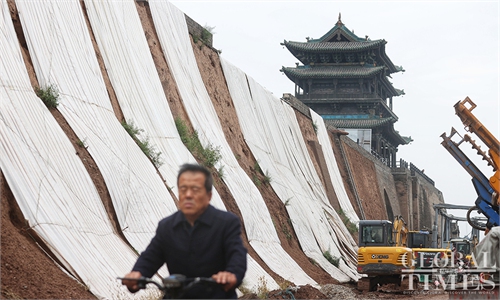China’s coal hub Shanxi emerges from floods, easing coal supply concerns
Government-led push helps ensure energy adequacy: expert

Construction workers and experts are working around the clock to repair a bridge on the Nantongpu railway in Jinzhong, North China's Shanxi Province. Photo: Cui Meng/GT
As the sun rises over the flooded areas in North China's Shanxi Province, the country's coal hub, woes over a downpour-exacerbated coal-fired power shortage are beginning to subside, as evidenced by the Global Times' onsite interviews in coal-mining regions.
With the province's coal exploration and deliveries emerging from the heavy rains, optimism about a recovery in the country's coal supplies during the fourth quarter is on the rise, according to industry insiders, citing a government-led tenacious push to ensure energy adequacy and market shifts expected already under way.
Coal mining back on track
Coal mines in Shanxi are busy producing and transporting shipments out of the province as they gradually resumed production after a temporary suspension due to torrential rainfall during the National Day holidays in early October.
During a recent visit to a coal mining area in a mountainous region of central Shanxi Province - Linfen and Jiexiu - the Global Times reporters saw streams of trucks full of coal from the local mines on the roads, with congestion and long lines of traffic at the entrance to expressways as they wait to transport coal to other regions.
A driver of a coal truck in Linfen, surnamed Chang, who usually transports coal from Linfen to neighboring Shaanxi Province told the Global Times the mudslide in mountain roads slowed down efficiency of coal to be transported to other regions. Drivers, instead, have to transport coal through expressway.
The Global Times learned that rockfalls, deep failure of slopes and shallow debris had blocked coal-transport lanes after the torrential rainfall hit the province, and many are yet to be declared free of danger. Global Times reporters saw warning signs and road workers clearing away scattered boulder and other debris that blocked the road.
"Despite rising costs, we've been extremely busy recently. Coal mines are eager to sell as prices for thermal coal have surged to a record high. Coal transportation orders are immediately picked up once they are made by producers and agencies," Chang added.
Of the 60 coal mines in Shanxi, which has a total 670 mines, that were forced to suspend production due to the downpours, 56 have resumed production. Authorities had said the brief suspension would not cause too much obvious influence on Shanxi's coal supply. Three mines in Linfen with a combined annual output capacity of 3.6 million tons were waiting to resume normal operations after final safety assessments, while another one is located in Taiyuan, with an annual output of 1.2 million tons, but cannot resume production due to blocked coal transport channels, reports said.
The Global Times learned from an interview with management at a coal mine in Jiexiu, a city next to Linfen, that local authorities have ordered coal mines to boost output to ensure supply as winter approaches under the premise of ensuring safety.
Feng Libing, general manager of Anyi Coal Mine Company in Jiexiu, told the Global Times "We have zero stockpiled coal as it's immediately transported as soon as we mine it. Some buyers even tried to find available coal through social connections."
When the rain was at its heaviest on October 5, coal production temporarily halted as workers had to evacuate the mine for safety reasons, but production quickly got back to normal after one day. "The rainfall basically didn't influence our production. The annual plan to mine 900,000 tons of coal won't be affected."
Improvement expected in Q4
Feng said his mine is ramping up efforts to complete the goal of producing more than 34,000 tons of mines for the country's fuel supply guarantee scheme this winter at the price of 500-600 yuan per ton, much lower than the market price.
Li Zhengmao, the head of the energy bureau of Jiexiu, told the Global Times that Jiexiu is home to 17 coal mines and this winter shoulders the responsibility of supplying 200,000 tons of mines to other regions in China and another 200,000 for local use. As most mines in Jiexiu are close to major transport routes, the rainfall had limited impact.
Findings from onsite interviews apparently serve to ease concerns over coal supplies that have been kept tight amid rising power demand as the economy continues to rebound and international commodity prices continue to surge.
Shanxi was the country's largest coal mining region in 2020 with 1.06 billion tons in output, an increase of 8.2 percent year-on-year, followed by North China's Inner Mongolia Autonomous Region with 1 billion tons of output, official data showed. The two provinces made up 53.7 percent of the country's coal output last year.
An improvement is well on the cards in coal supply terms heading into the fourth quarter, a coal analyst told the Global Times on Sunday on condition of anonymity, basing this optimism on a resolute governmental push for adequate energy supplies.
As the main coal-producing regions step up their mining capacities, coal supplies are estimated to maintain growth while coal demand growth is set to moderate, although coal prices would continue to fluctuate at a high level, the Securities Times reported Sunday, citing the China Coal Transportation and Distribution Association.
In the first 13 days of October, key coal mining firms of China tracked by the association posted average daily coal production of 6.93 million tons, up 4.5 percent from the month before, according to the report.
At a press briefing last week, the National Mine Safety Administration disclosed that 153 out of 976 coal mines it has inspected met the requirements for ensuring supplies in a safe manner and would result in an output increase of approximately 220 million tons per annum. That suggests a coal output rise of 55 million tons over the fourth quarter, with a daily addition of 600,000 tons, boding well for easing supply tightness and taming coal prices, per the administration.
The country's coal prices continued an upward trend in the week ending October 10, with thermal coal prices jumping 5.3 percent to 890 yuan per ton, showed data from the Ministry of Commerce.
There is little room for coal prices to spiral up, factoring in the government's reiterated vow to rein in coal rates, among other commodity prices, the analyst said.
While efforts to rev up coal production might still be dwarfed by the demand-supply gap, the eagerness of domestic power plants to stockpile coal tend to be in decline also, thereby leading to eased supply strains throughout the final quarter of the year, according to the analyst.
The industry veteran anticipated limited progress in coal imports however, citing skyrocketing global commodity prices as eradicating the appeal of imported coal that were previously cheaper than its domestically mined counterpart as one of the reasons behind lackluster imports.
In addition to the push to steady supplies, the country has put in place a power tariff reform that came into force on Friday with a wider market-driven power sales tariff band, as part of moves to maintain power supply stability while advancing the country's decarbonization pledge to shift the economy toward greener growth.
Not only coal power generators sporting higher operating efficiency and scale are expected to benefit from the new mechanism, operators of renewables such as nuclear and hydropower will benefit from the higher released tariffs, Moody's said in a research note sent to the Global Times.




